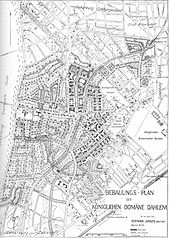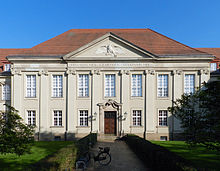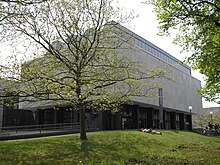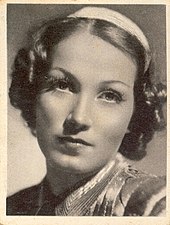Berlin-Dahlem
|
Dahlem district of Berlin |
|
|---|---|
| Coordinates | 52 ° 27 '29 " N , 13 ° 17' 15" E |
| surface | 8.39 km² |
| Residents | 16,929 (Dec. 31, 2019) |
| Population density | 2018 inhabitants / km² |
| Incorporation | Oct. 1, 1920 |
| Postcodes | 14169, 14195 |
| District number | 0605 |
| Administrative district | Steglitz-Zehlendorf |
Dahlem is a Berlin district in the Steglitz-Zehlendorf district . It is one of the wealthiest areas in Berlin.
Dahlem is located in the southwest of the city between the districts of Zehlendorf and Steglitz , the villa colony of Lichterfelde-West and the Grunewald forest . Many villas and small parks shape the image of the district. Numerous scientific institutions are located in Dahlem, including the Free University of Berlin . In addition, the Museum Center Berlin-Dahlem is a museum location of the Berlin State Museums with one of the world's most important ethnological collections.
history
Dahlem in the Middle Ages
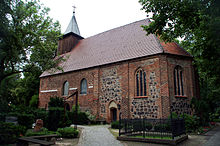
The village of Dahlem arose at the beginning of the 13th century between 1200 and 1220 "from wild roots", that is, without any Slavic pre-settlement. However, Slavs from small neighboring settlements that have been abandoned have apparently been resettled in the newly founded village as Kossaten . The first stone village church was probably built around 1300.
The first written mention of Dahlem comes from the year 1275 (Dalm) . In the lap register , a tax register of the time, there is a mention of the knight's court of Otto von Milow as early as 1450. The place Dalem , as it was called in the lap register, was 40 hooves in size at that time , of which the pastor was entitled to two duty-free hooves. There was also one church hoof and ten free hooves that Otto von Milow was entitled to. Three hooves were desolate , i. H. not used. After the death of the last Milow, the village of Dahlem and the Ritterhof went to the brothers Heinrich and Peter von Spiel before 1480, who already owned 20 of the 52 Hufen Dahlem in 1480. The other hooves were taxable; there was a farmyard . The von Spiel received the village with higher and lower jurisdiction, a lake and the right to fish there (1483). A residential courtyard by Spiel with a size of 14 hooves was mentioned as early as 1518. At that time there was still a jug . The representative manor house was built by the Spiel in 1560 and is now the oldest secular building in Berlin. In 1608 a manor appeared for the first time. In 1624 there were six farmers , four cottagers, a shepherd and a couple of householders living in Dahlem. In the Thirty Years War Dahlem was badly devastated; in 1652 "a man of 36 years" was still alive, all other farms and cottages had been destroyed. In 1655 the desolate Dahlem and the manor were sold to Georg Adam von Pfuel , who sixteen years later sold them to his nephew Cuno Hans von Wilmerstorff . The latter began intensive construction work in the village, which had been badly affected by the Thirty Years War. His efforts were partially successful: in 1688 a Schulze with six hooves lived in the village again . There were also 28 wild farmer's hooves belonging to the von Wilmersdorf family, two farms with one wild hoof each and a shepherd. The statistics recorded “17 people” for Dahlem.
Since 1700 the von Wilmersdorf owned the place hereditary and feudal. They had a vacant knight's seat and courtyard as well as 14 vacant knight's hooves, gardens and a vineyard. They also had higher and lower jurisdiction, church patronage and windmill justice (1715). The Schulzenhof had meanwhile fallen desolately again (1707), as was a Meierhof with six Hufen and two Sechshufnerhöfe. Only two Vierhufnerhöfe, two of the three Kossatenhöfe and the smithy, which first appeared in 1707, were occupied. A year later there was a windmill in the village. In 1711 there were two farriers, four farmers, a blacksmith, a shepherd, a shepherd, a foreman and a boy in the village. They each paid four groschen in taxes for the only 36 hooves in the area. From the year 1745 only two farmers, four cottagers, the windmill and the manor were reported. In 1771 there were six gables (= houses) in the village, in which, among others, the blacksmith, the shepherd, the shepherd, the foreman and the small farmhand lived. In 1799 the last Wilmerstorff sold Dahlem and Schmargendorf to Count Friedrich Heinrich von Podewils , who died in 1804. During his time as a landlord, the last farmers were relocated and replaced by farm workers.
At this time in 1800, Dahlem consisted of the village and estate with 14 fireplaces (= households). There were two whole farmers, three whole cottagers, a blacksmith, a jug, a windmill and a sheep farm. In the same year the forester's house Hundekehle appeared for the first time. For 80,000 dollars acquired Carl Friedrich von Beyme the estate. In 1804 Dahlem passed to the children of the princes of Schönburg and from there to the von Beyme family. In 1817 Dahlem existed with the Vorwerk Ruhleben, the forester's house Hundekehle and Wirtshaus Paulsborn. After Beyme's death in 1838, his daughter Charlotte von Gerlach sold the village to the Prussian domain treasury in 1841 . From 1901 the division of the Royal Domain Dahlem takes place with the aim of building an elegant villa village with attached scientific institutions ("German Oxford "). The neighboring Wilhelminian-style villas colonies of Lichterfelde-West and Grunewald were already a sought-after and expensive residential area. The tenant lived in the domain with 16 boys and maids and 35 day laborers. There were four workers and three servants. The domain was 1935 acres in size; there were also two smaller properties, which together only took up five acres. The statistics also recorded a master blacksmith, a tapkeeper and three poor. In 1860 the domain had a public, 12 residential and 14 farm buildings, including a distillery and a flour mill.
Development from 1901

Until the end of the 19th century, there was only the traditional connection between Steglitz and the Grunewald hunting lodge , from which today's Königin-Luise-Straße emerged, and the Dahlemer Weg, the connection to Schmargendorf and Zehlendorf . The plans of the Prussian cultural politician Friedrich Althoff to relocate the Botanical Garden from Schöneberg to Dahlem and for a science location ("German Oxford") led to the first changes in 1897. With the end of the last lease of the Dahlem domain in 1901, the development of the current form began. On March 25, 1901, the law on the division of the domain land came into force, for the implementation of which the Royal Commission for the division of the Dahlem domain was responsible. The first members of the commission were Hugo Thiel , Ministerialdirektor in the Prussian Ministry of Agriculture, Eberhard Ramm , Senior Government Councilor in the Prussian Ministry of Agriculture and until 1920 head of the Dahlem domain, Rudolf Zarnack, estate manager, Nathan Dorn, responsible for the sale of the land, three officials from the ministries involved as well the architect Walter Kyllmann . From 1910, the first director of the Kaiser Wilhelm Society, Adolf von Harnack, and court architect Ernst von Ihne also belonged to the commission. In 1919 it was renamed the State Commission for the Division of the Dahlem Domain . It was only dissolved in 1933 as part of administrative reforms. The commission was directly subordinate to the Prussian Ministry of Finance and Agriculture.
The commission decided to market the area for the villa colony itself in order to achieve a higher profit for the state and at the same time curb the land speculation. She met for many years in the Alten Krug on Königin-Luise-Strasse. As early as 1898 there was a plan by Walter Kyllmann for the development of the villa colony, which provided for a union with the already existing villa colonies in Grunewald, Steglitz and Lichterfelde in uniform parcelling. Based on this plan, the Rheinbaben- and Podbielskiallee together with the side streets and the Altensteinallee were built by 1907, and from 1902 the Habelschwerdter Allee, Goßlerstraße, Rudeloffweg, Von-Laue- and Bötticherstraße. The Habelschwerdter Allee, Schorlemer-, Lentze-, Engler-Thiel- and Pacelliallee were laid out in 1904 at the request of Wilhelm II. With a wide median for bridle paths. The Fabeckstraße, which was used as the approach path for the Guard Rifle Battalion to the shooting ranges in Grunewald, was paved on one half and provided with a marching and riding path on the other half. In 1908 the western part of the Königin-Luise-Straße, which led to the shooting ranges, was also paved. As early as 1905, the Steglitz tram operated here .
Kyllman's plan, which has undergone many changes over time, aroused much criticism because it took little consideration of the landscape of Dahlem. In 1907, Hugo Thiel therefore brought in the young architect Heinrich Schweitzer for further planning, which had become necessary, among other things, because of the planned incision path , who, together with the urban planner Hermann Jansen, developed a new development plan based on the aspects of landscape- related urban development. The newly created incision track therefore led in a wide arc with green embankments to what was then the terminus at the Thielplatz underground station . The newly planned streets were created in a curved network that followed the natural contour lines, which was intended to ensure optimal sun exposure of the property. The long green corridors Messelpark and Finkenpark as well as Thielpark and Schwarzer Grund offer many properties a park location.
Between 1901 and 1915, 539 plots of land for 27 million marks (adjusted for purchasing power in today's currency: around 82 million euros) with 384 new private buildings were built. The number of residents grew from 194 to 5500. The buyer was obliged to build a villa-like house within two years and had to pay a contractual penalty of 1000 marks per year if the deadline was exceeded. Due to the high land prices, the settlement of Dahlem was only reserved for the wealthy classes; this was not least ensured by the apportionment commission with its sales manager Nathan Dorn. Nevertheless, in the course of the settlement of authorities and research institutes in Dahlem, rental apartments for middle-class officials and scientists were built, such as in Ladenbergstrasse, in the area around Habelschwerdter Allee and on Corrensplatz.
During the implementation of the plans for a villa colony, interests collided with the concept for a "German Oxford" developed by Friedrich Althoff. The two development plans by Kyllmann (1899) and Schweitzer / Jansen (1911) tried to take the different interests into account. On the personal intervention of Kaiser Wilhelm II , large areas were therefore reserved for state buildings.
Incorporation to Berlin
On October 1st, 1920 the manor district of Berlin-Dahlem with 6244 inhabitants was incorporated together with the rural communities of Zehlendorf, Wannsee and Nikolassee as well as the manor districts of Kleinglienicke , Pfaueninsel and the northern part of Potsdam (Forst) in the district of Zehlendorf to Greater Berlin . This happened in spite of violent protests from the residents who wanted to leave the place independent as a “domain and villa town Dahlem”. The apportionment commission was retained, but now required the approval of the Berlin magistrate . When it was incorporated, Dahlem received the areas up to today's Waldfriedhof and today's Goldfinkweg west of today's Clayallee. In the years of the Weimar Republic the construction of numerous new residential buildings, the completion of the Secret State Archives , the construction of St. Bernhard and the Jesus Christ Church , the construction of the forest cemetery and the extension of the underground line. The science buildings of the Kaiser Wilhelm Society were also expanded and the Agricultural University was relocated. During this time, a number of modern buildings were built in Dahlem , of which the buildings by Hans and Wassili Luckhardt on Schorlemerallee are exemplary.
time of the nationalsocialism
A decisive change in the time of National Socialism was the displacement and emigration of Jewish and oppositional scientists and residents of Dahlem. Many residents of the district belonged to the leadership of the NSDAP after 1933 , such as Foreign Minister Joachim von Ribbentrop , Reichsbank President Hjalmar Schacht and Konstantin von Neurath , to name just a few. The National Socialist elite, such as Martin Bormann , Heinrich Himmler , SA chief of staff Viktor Lutze and Reich peasant leader Walther Darré moved into the villas of the displaced or dispossessed . Many well-known military men also lived in Dahlem. Including Wilhelm Keitel , Walther von Brauchitsch , Friedrich Paulus , Albert Kesselring , Erich von Manstein , Alfred Jodl , Heinz Guderian and Karl Dönitz .
New borders through the 1938 regional reform
The Berlin regional reform with effect from April 1, 1938 resulted in numerous straightening of the district boundaries as well as some major changes to the area, which also affected Dahlem. From now on, the northern border ran along Lentzeallee and Pücklerstrasse. The eastern border with Steglitz, which previously ran through the middle of the blocks, now formed the Englerallee and Altensteinstraße the border with Lichterfelde. In the south, the area south of Berliner Straße - with the State Materials Testing Office - was assigned to Lichterfelde and Schützallee became the southern border. In the west a piece of the Grunewald went from Wilmersdorf to Dahlem, so that the Grunewald hunting lodge is now in Dahlem. Due to the changed borders, the Botanical Garden , which was only partially located in Dahlem when it was founded , was now completely part of Lichterfelde.
The most important change, however, was the loss of the villa area around Rheinbabenallee, which was created as part of the first development phase from 1901 and still belongs to Dahlem in terms of urban development . This area comprised the line from the Wild Boar along Warnemünder Strasse, Hundekehlenstrasse, Hagenstrasse to Hömanstrasse, then along the Regerstrasse, Wildpfad, Waldmeisterstrasse, Goldfinkweg line to Pücklerstrasse, which from now on formed the northern border.
Development in the 1930s
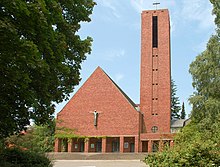
From 1936 to 1938, the Luftgaukommando III Berlin (later US headquarters ) was built on the then unused site on Kronprinzenallee (today: Clayallee ). Together with the official residential buildings on Saargemünder Straße, this facility, built by Fritz Fuß , is one of the first monumental buildings that testify to the new architectural style of the National Socialists . Another building from this period is the studio building for Arno Breker by Hans Freese , which was built between 1939 and 1942.
In 1938 the Wertheim family was forced to sell not only their department stores, but also their property on Messel- and Max-Eyth-Straße (today in Schmargendorf). The property was parceled out and the Villa Wertheim on it, designed by Max Landsberg , was demolished in 1910. Several residential buildings were built, including the Villa Riefenstahl for the director Leni Riefenstahl .
Synchronization and resistance
After the " seizure of power ", the National Socialists took over leadership of the research institutions and authorities. The institutes of the Kaiser Wilhelm Society placed themselves more or less voluntarily in the service of the National Socialists. As a result, Jewish scholars lost their jobs or resigned from their offices and fled abroad. These included Albert Einstein , who had already left Germany in December 1932 and never returned. His successor as director at the Kaiser Wilhelm Institute for Physics , the Dutchman Peter Debye , left Germany in 1939. After that, the institute was subordinated to the Army Weapons Office in order to research the use of nuclear fission .
After her teaching license was withdrawn in 1933, Lise Meitner, as an Austrian citizen, was initially able to continue her work at the (non-state) Kaiser Wilhelm Institute for Chemistry. After the annexation of Austria , however, as a native Jewish woman, she was particularly endangered and, thanks to Otto Hahn's help, was able to emigrate to Sweden in July 1938 .
At the Kaiser Wilhelm Institute for Physical Chemistry and Electrochemistry, all Jewish employees had already been dismissed in April 1933 due to the Aryan paragraphs . The director of the institute, Nobel Prize laureate Fritz Haber , retired in May 1933 and left Germany in autumn 1933 to go to Cambridge . The institute was placed under the army administration and military research was resumed.
Other institutes that put themselves in the service of the National Socialist cause were the Kaiser Wilhelm Institute for Anthropology, Human Heredity and Eugenics , the Reich Health Office , which under its new President Hans Reiter the department “Human Heredity and Racial Care for the Promotion of Hereditary Health, large family of German blood ”. The material testing institute and the institute for water, soil and air hygiene also fulfilled war-related tasks.
From 1931 until his imprisonment in 1937, Martin Niemöller was the pastor of the Protestant parish in Berlin-Dahlem , which under his leadership developed into a center of church resistance . Helmut Gollwitzer was his representative until 1940 . The second confessional synod of the Confessing Church was held in Dahlem in 1934, which proclaimed emergency church law .
building
There are numerous sights and museums in Dahlem. In addition, many internationally important science and research institutions have settled at the Dahlem science location.
In 1987, the Dahlem-Dorf metro station in Japan was named the most beautiful metro station in Europe. The spatial sculptures Lovers on the Platform were created by the Berlin-based sculptor Wolf van Roy who died in 2012 .
Attractions
- Grunewald hunting lodge with a collection of paintings
- Philological library of the Free University of Berlin by architect Lord Norman Foster
- St. Anne's Church
The botanical garden, which is often ascribed to the district of Dahlem, is not in Dahlem, but has been in Lichterfelde since Greater Berlin was founded in 1920 . Originally (1895) around a quarter of the area belonged to the Dahlem district (see graphic in the article Botanical Garden Berlin ).
Museums
- Museum Center Berlin-Dahlem with the Museum of European Cultures
- Domain Dahlem - open-air museum of agricultural history
- Bridge Museum
- Allied Museum on the History of the Cold War in Berlin
- Ruin of the arts
- Kunsthaus Dahlem
Science location Dahlem

- Free University of Berlin , for example with the Dahlem Center of Plant Sciences
- Max Planck Society , emerged from the Kaiser Wilhelm Institutes , which were founded in Dahlem.
- Federal Institute for Materials Research and Testing
- German Archaeological Institute
- German university for further education
- Konrad Zuse Center for Information Technology Berlin
- Secret Prussian State Archives
- Institute for Museum Research
- Institute for Occupational Medicine at the Charité
- Julius Kühn Institute - Federal Research Institute for Cultivated Plants (JKI)
Personalities
Sons and Daughters of Dahlem
- Brigitte Horney (1911–1988), actress
- Karl-Eduard von Schnitzler (1918–2001), chief commentator of the German TV broadcaster in the GDR and creator of the program The Black Channel
- Hanno Hahn (1922–1960), art historian, architectural researcher; only son of Otto Hahn
- Konrad Kraske (1926-2016), politician (CDU)
- Maurus Berve OSB (1927–1986), Benedictine monk and abbot of the Neuburg Abbey near Heidelberg
- Götz von Boehmer (1929–2019), legal scholar and ambassador a. D.
- Paul Mersmann the Younger (1929–2017), sculptor, painter and writer
- Edgar Ott (1929–1994), actor and voice actor (e.g. for Benjamin Blümchen )
- Nora von Collande (* 1958), actress and author
Other people associated with Dahlem
- Adolf Jandorf (1870–1932), entrepreneur, founder of KaDeWe ; lived with his family in the Villa Gelfertstrasse 32–34.
- Ludwig Fulda (1862–1939), playwright and translator as well as persecuted by National Socialism ; lived in Dahlem.
- Arthur Zarden (1885–1944), financial expert and in the Weimar Republic State Secretary in the Reich Ministry of Finance and persecuted by National Socialism; lived in Dahlem.
- Max Baldner (1887–1946), cellist, music teacher and persecuted by National Socialism; lived in Dahlem.
- Gustav Stolper (1888–1947), economist, business journalist and liberal politician as well as persecuted by National Socialism; lived in Dahlem.
- Bruno Asch (1890–1940), local politician of the SPD and persecuted by National Socialism; lived in Dahlem.
- Kurt Hueck (1897–1965), botanist and persecuted by National Socialism; was director of the Institute for Agricultural Botany, which was located in Dahlem.
- Fritz Lang (1890–1976), director and screenwriter; lived in Schorlemerallee 7a.
- Toni Stolper (1890–1988), economist and journalist as well as persecuted by National Socialism; lived in Dahlem.
- Camilla Spira (1906–1997), actress and persecuted by National Socialism; lived in Dahlem.
- Brigitte Helm (1908–1998), film actress, best known to this day for her role in Metropolis ; lived in Schorlemerallee 12.
- Hildegard Knef (1925–2002), actress, chanson singer and author; survived the last weeks of the war as a young drama student at Villa Gelfertstrasse 37, where she was staying as the lover of the then resident, the Reichsfilmdramaturg Ewald von Demandowsky (1906–1946). He bought the villa in 1939 after the Jewish owners were expropriated.
Climate table
| Berlin-Dahlem | ||||||||||||||||||||||||||||||||||||||||||||||||
|---|---|---|---|---|---|---|---|---|---|---|---|---|---|---|---|---|---|---|---|---|---|---|---|---|---|---|---|---|---|---|---|---|---|---|---|---|---|---|---|---|---|---|---|---|---|---|---|---|
| Climate diagram | ||||||||||||||||||||||||||||||||||||||||||||||||
| ||||||||||||||||||||||||||||||||||||||||||||||||
|
Average monthly temperatures and precipitation for Berlin-Dahlem
Source: wetterkontor.de
|
|||||||||||||||||||||||||||||||||||||||||||||||||||||||||||||||||||||||||||||||||||||||||||||||||||||||||||||||||||||||||||||||||||||||||||||||||||||||||||||||||||||
See also
- List of streets and squares in Berlin-Dahlem
- List of cultural monuments in Berlin-Dahlem
- List of cinemas in Berlin-Dahlem
- List of stumbling blocks in Berlin-Dahlem
literature
- Michael Engel : History of Dahlem. Berlin-Verlag, Berlin 1984, ISBN 3-87061-155-3 .
- Wolfgang H. Fritze : Dahlem St. Annen. Times of a village and its church. Berlin 1989.
- Harry Balkow-Gölitzer: A noble address: Celebrities in Berlin-Dahlem and their stories. Berlin edition, Berlin 2005, ISBN 3-8148-0136-9 .
- Dietrich Hahn : Otto Hahn - life and work in texts and pictures. Foreword by Carl Friedrich von Weizsäcker . Suhrkamp-Insel, Frankfurt am Main 1988. ISBN 3-458-32789-4 .
- Eckart Henning , Marion Kazemi : Dahlem - Domain of Science. A walk to the Berlin institutes of the Kaiser Wilhelm / Max Planck Society in the “German Oxford”. Archive for the history of the Max Planck Society, Berlin 2002, ISBN 3-927579-16-5 .
- Domain Dahlem: Dahlem - St. Annen: times of a village and its church. Domain Dahlem, Berlin 1989, ISBN 3-9802192-1-6 .
- Carl-Philipp Melms: Chronicle of Dahlem, 1217 to 1945: From the manor to the urban domain. arani, Berlin 1957 and 1982, ISBN 3-7605-8528-0 .
- Lieselott Enders : Historical local lexicon for Brandenburg: Teltow (= Historical local lexicon for Brandenburg . Volume 4). Verlag Hermann Böhlaus successor, Weimar 1976.
Web links
- Sebastian Wandersee: Out in Dahlem . District Office Steglitz-Zehlendorf on Berlin.de.
Individual evidence
- ↑ That's how much money Berliners have at their disposal . In: Berliner Morgenpost , February 28, 2010. Accessed on March 26, 2014. Due to the above-average income of the residents and the predominantly villa development, the district enjoys a high level of social prestige. The “prosperity” does not refer to the budget of the Steglitz-Zehlendorf district, to which Dahlem belongs.
- ^ Pfuel, Georg Adam von. In: The Thirty Years' War in personal testimonies, chronicles and reports. March 28, 2012. Retrieved April 28, 2017 .
- ↑ Church emergency law: Second Dahlem Confessional Synod in the exhibition "On the way to a responsible community"
- ^ List, map, database / Senate Department for Urban Development and Environment - Berlin. Retrieved October 4, 2017 .


